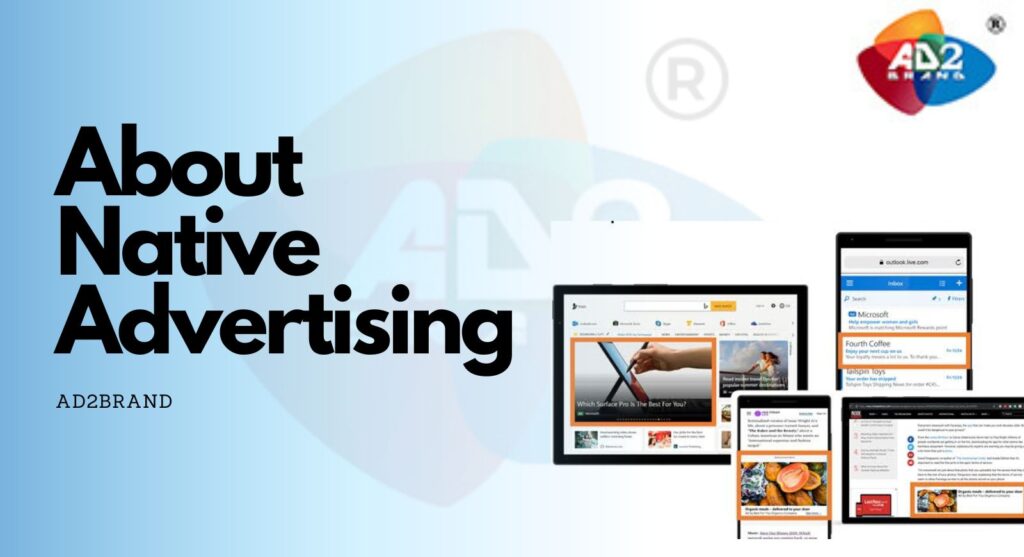What Is Native Advertising?
Native advertising means creating ads that seamlessly blend into the content of a page, matching its design and behaving like a natural part of the platform.
Examples of native ads include promoted search results and sponsored social media posts. They offer similar value to users as regular search results and posts created by users themselves.
With people becoming less responsive to traditional ads like banners and displays, big brands and new startups are investing more in content marketing and less intrusive ad styles.
Experts predict that the worldwide market for native ads will exceed $402 billion in yearly revenue by 2025.
How Do Native Ads Work?
Native ads work by connecting publishers who have space for ads with advertisers aiming to reach specific audiences for various purposes like boosting awareness, sales, or lead generation.
Here’s how it happens: When a user visits a website with available ad space, the publisher’s platform asks potential advertisers for bids through a supply-side platform (SSP). Advertisers respond via a demand-side platform (DSP) with their bids and details. The highest bidder gets their ad displayed to the user.
What Do Native Ads Look Like?
Native ads blend seamlessly into the content they’re placed within, fitting naturally and unobtrusively. They often resemble regular articles or content, especially when the aim is to increase brand awareness. Unlike typical ads, they might not use common sales language like “purchase,” “subscribe,” or “sign up.”
Native Advertising Channels Explained
Native advertising operates through various channels, whether managed manually or using automated systems:
Search Engines In search engines like Google and Yahoo, native advertising emerged with sponsored search results, creating a new form of “native” content.
Social Media Platforms Platforms such as Facebook and Instagram introduced native ads within user feeds, utilizing formats like in-feed and carousel ads.
Websites on the Open Web Content discovery platforms like Taboola drive personalized content suggestions and in-feed native ads across well-known publisher websites.
Who Benefits from Native Advertising?
- Advertisers, Both large corporations and emerging businesses leverage native ads to connect with audiences at pivotal moments when individuals are actively consuming content, increasing the potential impact of their campaigns. These ads efficiently utilize ad spending to achieve objectives spanning from broad brand recognition to generating leads and sales.
- Publishers Native ads have become an essential tool for publishers to monetize content across various platforms and devices. These opt-in native units prompt valuable user actions while preserving the overall user experience (UX). They direct users to high-value pages like videos, sponsored content, microsites, and more.
- Users Unlike disruptive pop-ups or pre-roll ads, native ads establish a more respectful interaction with users, allowing individuals to explore and engage with branded content at their own pace and based on their preferences. This approach empowers users to discover content they might enjoy without feeling imposed upon.
How to find the Best Native Advertising Platform
When aiming for success with native advertising, many publishers and advertisers join forces with tech partners. These partnerships assist in content distribution, audience engagement, and monetization across platforms.
Content discovery platforms, such as Taboola, have surged in popularity for this purpose. They attract billions of monthly users and match them with personalized content using predictive algorithms, akin to those of major social networks.
Checklist for Choosing the Right Content Discovery Platform
- Network Quality What types of websites or page placements does the platform cover?
- Tracking Does the platform provide transparent access to performance metrics like cost-per-acquisition, pages-per-visit, viewable impressions, and conversions?
- Scale How many users does the platform reach in your target regions?
- Compatibility How well does the platform integrate with different hardware and software solutions, such as devices, operating systems, and CRM software?
- Targeting What targeting and retargeting capabilities does the platform offer? For instance, behavioral, demographic, B2B, or B2C targeting?
- Service Does the partner offer flexible self-service options and account management support?
- Bidding Models Can you manually set CPC bids for auctions, or does the platform allow CPC adjustments to optimize conversions? Are other models available like CPA, CPV, or CPM?
- Auction Transparency Are the auctions transparent, and what types of auctions are available?
Choosing the Right Native Ad Units
Different ad units perform based on factors like placement, audience, and desired actions. While there’s no universal solution, specific formats tend to excel, delivering high impressions and conversions for both publishers and advertisers.
Native Ad on Publisher Homepage
Best for:Brand Awareness & Thought Leadership Campaigns
Impactful placement for publishers and advertisers, offering premium CPCs. Builds trust by associating with the day’s top editorial headlines.
Native Ad Mid-Article
Best for: Engaging Transient Visitors
Engages curiosity, particularly effective for mobile users. Offers full-screen exposure, helping publishers monetize traffic with higher viewability rates.
Native Ad Below Article
Best for: Performance Advertising
Targets users post-content consumption, ideal for discovering something new. Reports higher engagement post-click compared to other referral sources like search or social.
Native advertising is more than just ads; it’s a way to seamlessly blend promotional content into the pages we browse, becoming a natural part of the platform. These ads, whether they’re promoted search results or sponsored social media posts, feel like regular content to users, offering value akin to what they find organically. In a world where traditional ads like banners lose their impact, businesses are shifting toward native ads, where big brands and startups invest more in content marketing and less in intrusive ad styles.




